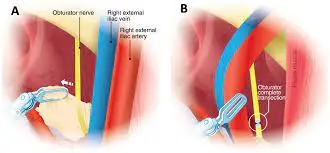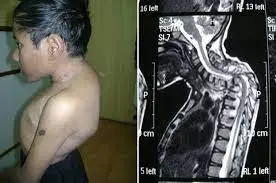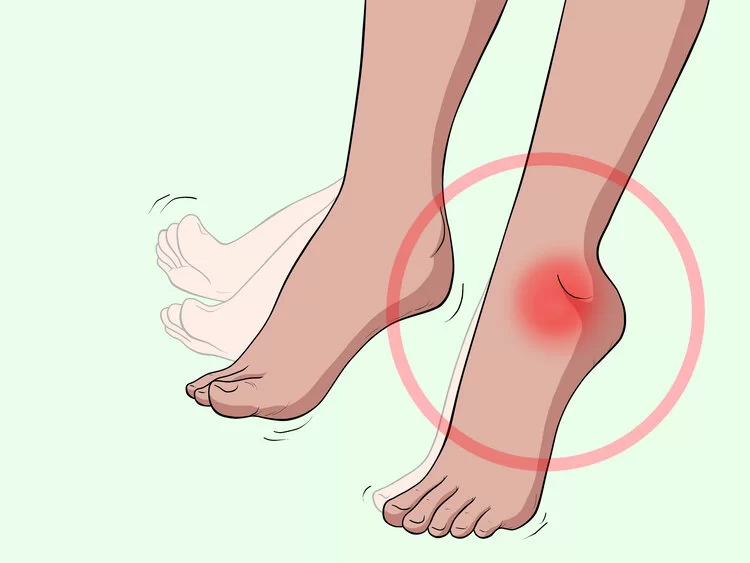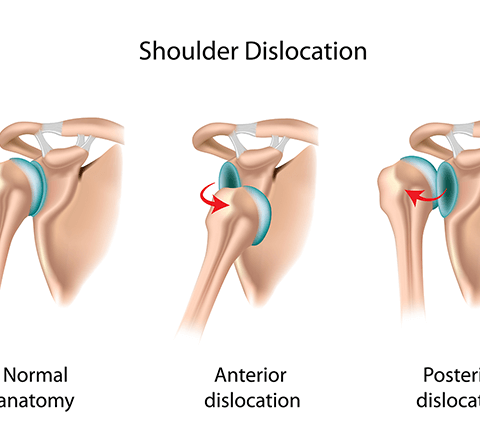Obturator Nerve Injury
An obturator nerve injury is damage to the obturator nerve, which originates in the lower back from the lumbar plexus. In the groin is where the obturator nerve is situated. Through the pelvis and into the inner thigh, the obturator nerve provides motor function and sensation to the muscles that aid adducting (bringing the legs together).
This article includes causes, symptoms, and treatment of obturator nerve injury.
What is the Obturator Nerve?
- One of the many peripheral nerves that run through your groin is the obturator nerve. It is an integral part of the peripheral nerve system in your body. The brain and body can communicate more easily because of this system.
- Your obturator nerve (nerve root) begins at your lumbar plexus. Your lower limbs may move and feel (innervation) thanks to a network of nerves called the lumbar plexus. These consist of your foot, upper, and lower legs.
What other nerves are located in the area of the groin?
Here are several more nerves are present in the groin area:
- Femoral nerve.
- Genitofemoral nerve
- Ilioinguinal nerve.
- Lateral femoral nerve.
What is the anatomy of the Obturator Nerve?
The nerve fibers that make up your obturator nerve begin in your lower spine. This comprises the backbones, or vertebrae, L2, L3, and L4. The route of your obturator nerve is as listed below:
- Passing through the psoas muscle tissue in a downward motion.
- Moving along the side of your pelvic wall and behind your iliac artery.
- Entering your thigh region after going through an obturator canal and a nearby tissue opening.
When the obturator nerve reaches your groin region, it splits into three main branches:
- Anterior(front): The muscles that help flex your hip are sensed by the anterior (front) region.
- Cutaneous(skin): The skin on the upper portion of your inner thigh is sensed by the cutaneous, a further branch off of your anterior branch.
- Posterior(back): The posterior, or back, pulls your thighs together and permits hip rotation.
Your pectineus muscles in your inner and upper thighs occasionally receive motor function from your anterior branch as well. These muscles are normally moved by the femoral (thigh) nerve, however in rare cases, normal anatomy could be different.
What is the function of the Obturator Nerve?
Your inner thigh receives this nerve’s motor (muscle movement) and sensory (feeling) functions.
The following motor functions are supported by the muscles of your obturator nerve:
- At the knee, extend your leg.
- At your hips, flex.
- When walking and standing, keep your equilibrium.
- Move your leg out from under your body.
- Step your foot out from under you.
Your obturator nerve gives you sensation in the following areas for sensory functions:
- Hip joint.
- Knee joint.
- The inside of your upper thighs, close to your groin, is partially covered in skin.
Another function of the Obturator Nerve
To reduce sensation(nerve block), medical professionals may inject medicine into your obturator nerve.
- An obturator nerve block might be necessary to numb your groin before knee or hip surgery.
- Avoid unintentional leg jerks when undergoing pelvic surgery, including treatment for bladder cancer.
- Relieve thigh or groin pain that is resistant to conventional treatments.
- Treat your inner thigh’s abnormal muscle tightness or spasticity. Those who have multiple sclerosis occasionally experience this.
What are the causes of the Obturator Nerve Injury?
The following are typical causes of the Obturator Nerve injury:
- Nerve entrapment occurs when abnormal pressure from surrounding tissue, such as bulging ligaments, and pelvic disorders like endometriosis, causes nerves to stop working. Pregnancy can cause nerve compression.
- Obturator neuropathy: Unusual wear and tear or an unexpected injury might result in nerve damage.
- Obturator hernia: Pressing on your obturator nerve is the result of abdominal tissue pushing through your obturator canal.
- Pelvic trauma: This type of injury can result from internal hemorrhage that compresses the nerve during childbirth or from crush injuries like those sustained in auto accidents.
- Cancer or pelvic tumors: Unusual growths can develop on your rectum, cervix, bladder, and more.
- Sports injuries: These can happen in sports like football where kicking is a common activity. It also occurs in sports like riding horses or cycling that require extended durations of sitting.
Additional conditions that can lead to injury to the obturator nerve:
Your obturator nerve may be affected by complications from pelvic surgery. There are a lot of intricate structures here. It provides little room to maneuver surgical equipment. When attempting to access the surgery site, healthcare providers run the risk of injuring your nerve. Your obturator nerve may be momentarily squeezed, stretched, or less frequently damaged by surgical hardware during the procedure.
Leg postures that require your leg to be placed away from your body during labor or certain surgeries can cause strain on your obturator nerve.
Obturator neuropathy can result from some surgical procedures, such as:
- Lymph node dissection for cervical cancer in the groin.
- Repair of pelvic organ prolapse.
- Stress incontinence was treated with a trans obturator tape (TOT) procedure.
- Radical prostatectomy and hysterectomy.
- Treatment for fibroids using uterine artery blockage.
What signs and symptoms indicate an injury to the Obturator Nerve?
The following are the most typical signs of an obturator nerve injury:
- Pain in the pelvic region, groin, or inner thighs.
- weakness in the muscles of the inner thighs, which can make walking and stair climbing challenging.
- Inner thigh numbness or tingling.
- Having trouble adducting the legs.
- Reduced feeling in the thigh, occasionally extending to the calf.
What are the risk factors for the Obturator Nerve Injury?
You may be at higher risk of an obturator nerve injury if you have had previous surgeries, injuries to the pelvis or thigh, or hematomas. By appropriately warming up before hard activity and stretching frequently, athletes can lower their risk.
What is the diagnosis for the Obturator Nerve Injury?
Given the variety of possible causes, including hernias, tendinitis, stress fractures, and bursitis, persistent discomfort in the groin and thigh can be difficult to identify. The obturator nerve is located deep in the thigh, thus several tests could be required to identify an injury, including:
- Physical examination: To determine the cause of your pain, the doctor will feel for any soreness in your groin area and inquire about any changes in your senses.
- Magnetic resonance imaging (MRI) and computed tomography (CT scans): look for growths that may be compressing the obturator nerve, such as tumors or hematomas.
- Electromyography (EMG): examines the response of muscles and nerves to determine if the muscles react suitably to stimulus.
What are the treatments for the Obturator Nerve Injury?
The degree of the injury and its underlying cause will determine the course of treatment for an obturator nerve injury. With conservative care, such as the following, the nerve may occasionally recover on its own. Physical rehabilitation, pain treatment, and in certain situations, surgical repair are available options for treating an obturator nerve injury.
Conservative Treatment for the Obturator Nerve Injury
Rest and Activity Modification:
- Rest and avoiding activities that increase symptoms are common components of initial treatment. This helps the nerve heal by preventing additional harm.
Heat and Cold Therapy:
- Pain and swelling at the site of injury can be lessened by applying heat or cold packs () .
Medications:
- Medicines that reduce pain and inflammation.
- Medications that calm muscles if there are spasms.
- Neuropathic painkillers like pregabalin or gabapentin.
- Local anesthetic injections block the obturator nerve from sending pain signals. This can also be used as a diagnostic tool to figure out the pain’s origin.
Physical Therapy for the Obturator Nerve Injury
- Pain management: To relieve persistent pain, electrical therapy is used, such as transcutaneous electrical nerve stimulation (TENS) and ultrasound.
- Strengthening exercises: Mainly targeted at the adductor muscles, which are innervated by the obturator nerve. This could improve function and reduce pain.
- Stretching exercises: Maintaining flexibility and decreasing muscle tension can be achieved by gently stretching the hip and thigh muscles.
- Neuromuscular Re-education: Methods for improving coordination and retraining affected muscles.
- Functional training: Consists of exercises aimed to help patients get better at carrying out everyday activities and get back to their daily routines.
Surgical treatment for the Obturator Nerve Injury
When conventional treatments are ineffective at treating symptoms and EMG testing shows severe lesions to the nerve, surgery may be required to regain full function.
Nerve Decompression
- If your obturator nerve is being compressed by scar tissue, a tumor, or another growth, nerve decompression surgery can remove the underlying cause and relieve pressure on the nerve. By making just three tiny incisions, doctors can relieve the injured nerve from whatever has compressed it with this innovative, minimally invasive surgery.
- The majority of patients have great pain reduction and quick regaining of some sensation and mobility in their groin and thigh following an hour and a half of nerve decompression surgery. They can normally return to their regular activities after two or three weeks. They can achieve even more considerable and long-term gains with the help of physical therapy.
Nerve Repair
- If the damage to the obturator nerve is too great for decompression therapy to cure, some individuals may benefit from nerve repair surgery.
- To fix the nerve and get function back, scar tissue from the nerve endings needs to be removed. The nerve is then reattached using a small suture.
- Depending on the severity of the damage, recovery periods might be different and the process could take more than two hours. While nerve function can sometimes be recovered rapidly, in other cases it may take several months for the damaged muscle to heal entirely.
Nerve Transplant or Nerve Grafting
- Severe nerve injury can cause a large section of the nerve to get crushed or to disappear. In a nerve transplant, also known as a nerve graft, the gap is filled with nerve tissue that is either autografted taken from another part of the body or allografted taken from a corpse. The nerve will regrow through the transplant to regain movement and sensation, much like when a wire is reconnected.
- It may take many hours to finish a nerve transplant. While the nerve fibers need time to regenerate, recovery may take several weeks or months.
Prognosis
Recovery times for obturator nerve injuries can vary depending on their severity. In certain cases, patients could heal in a matter of weeks. But it can take a few months or perhaps a year for the nerve to heal completely. There are situations where the nerve might not recover all the way, leaving the patient with persistent inner thigh pain or paralysis.
What are the preventions for obturator nerve injuries?
Certain obturator neuropathy causes may not be preventable. Crush injuries or postpartum trauma may be beyond your control.
- You can reduce the amount of pressure on your pelvis by adjusting the foot straps on horse saddles or the seat height on bicycles to prevent obturator nerve sports injuries.
- Allowing adequate time for warm-up before engaging in sports.
- Resistance exercise to build stronger legs and lower abdominal muscles.
- When you feel groin pain, take a break rather than push through it.
- Preserving a healthy weight helps lessen the strain on the thigh and hip regions.
- Utilizing good posture and ergonomics when performing regular tasks to avoid getting injured.
Summary
An obturator nerve injury is a disorder that can seriously impair a person’s leg and thigh mobility. In the groin is where the obturator nerve is situated. It makes your inner thigh’s muscles and sensation possible. Sports injuries and post-operative complications from medical procedures can cause obturator nerve injury(obturator neuropathy).
A combination of treatments is used to treat obturator nerve injury, consisting of conservative management, physical therapy, medication, and, in certain situations, surgery. For individuals with obturator nerve injury, early identification and effective treatment are essential to reducing long-term impairment and improving their quality of life.
FAQs
Which muscles would be impacted if the obturator nerve were injured?
The only atrophying muscle in the thigh’s medial compartment is the adductor magnus, which is innervated by the obturator nerve. The motor impairment is restricted to adduction, and particularly, adductor weakness does not significantly impact gait but makes leg crossing difficult.
What signs and symptoms indicate an injury to the obturator nerve?
Depending on the extent of the nerve damage, obturator nerve injuries can present with a variety of symptoms. Numbness, tingling, burning, or pain in the inner thigh or groin are typical symptoms. Decreased feeling in the thigh, maybe extending to the calf.
What are the causes of the obturator nerve injury?
Sports-related injuries, tumor compression, bleeding, and surgery are among the recognized causes of obturator nerve injury.
What is the diagnostic process for obturator nerve injury?
Physical examination and imaging tests, such as computed tomography (CT), magnetic resonance imaging (MRI), or ultrasound, are currently used to detect obturator nerve injuries.
How is an obturator nerve blocked?
To block the anterior branch of the obturator nerve, local anesthetics are injected using in-plane ultrasound guidance into the fascia between the pectineus and adductor brevis muscles or between the adductor longus and adductor brevis muscles.
References
- Professional, C. C. M. (n.d.-k). Obturator nerve. Cleveland Clinic. https://my.clevelandclinic.org/health/body/22348-obturator-nerve
- Obturator Nerve Injury | The Institute for Advanced Reconstruction. (n.d.). https://www.advancedreconstruction.com/body/obturator-nerve-injury
- Obturator nerve entrapment – City Hospital, Dehradun. (n.d.). City Hospital, Dehradun. http://cityhospitaldehradun.com/sports-injuries/obturator-nerve-entrapment/
- Obturator nerve entrapment – groin – conditions – musculoskeletal – What we treat – physio.co.uk. (n.d.). https://www.physio.co.uk/what-we-treat/musculoskeletal/conditions/groin/obturator-nerve-entrapment.php
- Obturator Nerve Entrapment – Page 8 – ZWAN. (n.d.). https://www.bizwan.com/en/index.php?view=article&id=82:proximal-entrapments-of-the-lower-extremity&catid=86&start=7








Here in Sweden, doctors are telling me that surgery isn’t even an option, no one knows how to perform on, and that it’s never done. Where can I find a suregeon within the European Union to help me?
I’m sorry to hear about the challenges you’re facing in finding appropriate surgical care for your obturator nerve injury in Sweden. While such injuries are relatively rare, surgical intervention is sometimes considered, especially in cases where conservative treatments have not yielded satisfactory results.
Understanding Obturator Nerve Injury and Surgical Considerations:
Obturator nerve injuries can occur as complications during pelvic surgeries, with reported incidences ranging from 0.2% to 5.7% in such procedures. Management strategies depend on the type and extent of the injury. In cases of nerve transection, immediate intraoperative repair has been associated with favorable outcomes.
Seeking Specialized Surgical Care within the European Union:
Given the specialized nature of this condition, it’s essential to consult with surgeons experienced in pelvic nerve injuries. Here are steps to help you identify potential specialists within the EU:
Consult Academic Medical Centers:
Reach out to leading academic hospitals in countries like Germany, France, and the Netherlands, which are known for advanced neurosurgical departments.
These centers often have specialists in peripheral nerve injuries and may offer the expertise you require.
Explore Specialized Clinics:
Investigate clinics dedicated to nerve injuries or neurosurgery.
For example, the Peripheral Nerve Surgery Unit at the Hospital Clínic de Barcelona in Spain specializes in such procedures.
Contact Professional Associations:
The European Association of Neurosurgical Societies (EANS) can provide information on specialists across Europe.
They may assist in connecting you with professionals experienced in obturator nerve injuries.
Seek Second Opinions:
Consider obtaining a second opinion from a neurosurgeon or orthopedic surgeon with expertise in nerve injuries.
This can help determine the feasibility and potential benefits of surgical intervention in your specific case.
Next Steps:
Compile Medical Documentation: Gather all relevant medical records, including imaging studies and previous assessments, to share with potential specialists.
Initiate Contact: Reach out to the identified centers or specialists to inquire about consultation availability, treatment options, and the possibility of surgical intervention.
Evaluate Logistics: Consider factors such as travel, accommodation, and insurance coverage when planning for consultations or treatments abroad.
By exploring these avenues, you can identify a surgeon within the European Union who possesses the expertise to assess and potentially treat your obturator nerve injury. It’s crucial to have a thorough evaluation to determine the most appropriate course of action for your condition.